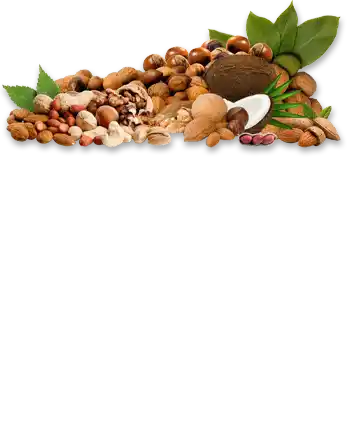Going Nuts About Nuts
Every August 3rd, we celebrate National Grab Some Nuts Day, a day dedicated to the appreciation of one of nature's most versatile and nutritious snacks. Whether you’re a fan of almonds, cashews, peanuts, or walnuts, this day is all about going a little nutty in the best possible way. So, let’s dive into the fascinating world of nuts, packed with history, nutrition, and a touch of humor.
The Nutty History
Nuts have a storied past that stretches back thousands of years, deeply rooted in human history and culture. These small but mighty morsels have played significant roles in diets, economies, and even religions across the globe. Let’s journey through time and explore the fascinating history of nuts.
Ancient Beginnings: Nuts were among the first foods consumed by humans. Archaeological evidence suggests that early humans gathered and ate nuts as far back as 780,000 years ago. Fossilized remains of wild almonds, acorns, and other nuts have been found in ancient settlements, indicating their importance as a food source.
In ancient Persia (modern-day Iran), almonds were cultivated and highly valued. They were not only a nutritious snack but also a symbol of prosperity. Almonds found their way into the diets of Egyptians and were even placed in the tombs of Pharaohs as a testament to their value.
Nuts in Ancient Civilizations: The Romans were particularly fond of walnuts, referring to them as "Jupiter's royal acorn," symbolizing their belief that walnuts were food for the gods. Walnuts were introduced to Europe from Persia and became a staple in Roman cuisine and medicine. They believed walnuts had health benefits and used them in various remedies.
 In ancient China, walnuts were prized for their supposed medicinal properties and were believed to promote brain health due to their brain-like shape. Cashews, native to Brazil, were discovered by Portuguese explorers and quickly spread to Africa and India, where they became integrated into local cuisines and economies.
In ancient China, walnuts were prized for their supposed medicinal properties and were believed to promote brain health due to their brain-like shape. Cashews, native to Brazil, were discovered by Portuguese explorers and quickly spread to Africa and India, where they became integrated into local cuisines and economies.
Nuts in the Middle Ages: During the Middle Ages, nuts remained a crucial part of the diet, especially in Europe. They were often used in cooking and baking, providing essential fats and proteins in a time when meat was not always readily available. Almonds were particularly popular and were used to make almond milk, a staple in medieval kitchens due to its versatility and long shelf life.
The Age of Exploration: The Age of Exploration (15th to 17th centuries) saw nuts traveling across the globe. Explorers and traders introduced nuts to new regions, leading to the cultivation of various nut species in different climates. The Portuguese introduced cashews to India and Africa, where they thrived and became integral to local diets and economies.
Nuts in the Modern Era: In the modern era, nuts have continued to be a beloved snack and ingredient worldwide. Advances in agriculture and trade have made a wide variety of nuts available year-round, no matter the location. The United States became a major producer of several types of nuts, with California leading the charge in almond, walnut, and pistachio production.
Peanuts, while technically legumes, gained immense popularity in the United States. They became a staple crop in the southern states, thanks to agricultural scientist George Washington Carver, who promoted their cultivation to improve soil health and provide an alternative to cotton.
Cultural and Economic Impact: Nuts have not only been a dietary staple but also a cultural and economic powerhouse. Festivals celebrating nuts, like the National Peanut Festival in Alabama and the California Walnut Festival, highlight their importance in regional cultures. Economically, nuts contribute significantly to agricultural revenue in many countries, supporting millions of jobs worldwide.
The Nut Renaissance: In recent years, nuts have experienced a renaissance, praised for their health benefits and versatility. As part of a balanced diet, they are recognized for their heart-healthy fats, protein, fiber, vitamins, and minerals. Innovations in the food industry have led to new nut-based products like almond milk, nut butters, and nut-based snacks, further cementing their place in contemporary diets.
From their ancient origins as a vital food source to their modern status as a nutritional powerhouse, nuts have been an essential part of human history. Their journey through time reflects their adaptability and enduring appeal. So, as you grab a handful of nuts on National Grab Some Nuts Day, remember the rich history and global journey that brought these delicious morsels to your snack table.
What Makes Nuts So Nutritious?
Nuts are small but mighty when it comes to nutrition. They are packed with healthy fats, protein, vitamins, and minerals. Here’s a closer look at what makes nuts a superfood:
- Healthy Fats: Nuts are rich in unsaturated fats, which are good for heart health. These fats help reduce bad cholesterol levels and lower the risk of heart disease.
- Protein Power: A handful of nuts can provide a significant amount of protein, making them an excellent snack for vegetarians and anyone looking to boost their protein intake.
- Vitamin E: This powerful antioxidant is abundant in nuts, helping to protect cells from damage and promoting healthy skin.
- Minerals: Nuts are a great source of essential minerals like magnesium, phosphorus, and zinc, all of which play crucial roles in bodily functions.
The Variety Pack
Nuts come in all shapes and sizes, each with its unique flavor and health benefits. Let’s crack open a few fun facts about some popular nuts:
- Almonds: Known as the “king of nuts,” almonds are a rich source of vitamin E, magnesium, and fiber. They are often enjoyed raw, roasted, or as almond butter.
- Cashews: These kidney-shaped nuts are high in healthy fats and minerals like copper and magnesium. They are perfect for creamy cashew butter or added to stir-fries.
- Walnuts: With their brain-like appearance, walnuts are known for their omega-3 fatty acids, which are great for brain health. They add a delightful crunch to salads and baked goods.
- Peanuts: Technically a legume, peanuts are a favorite worldwide. They are high in protein and often enjoyed as peanut butter or in savory dishes like Thai peanut sauce.
- Pistachios: These green gems are not only delicious but also packed with antioxidants. Pistachios are often enjoyed as a snack or used in desserts like baklava.
The Fun Side of Nuts
Nuts aren’t just nutritious; they also come with their share of fun and quirky facts:
- World Record: The world record for the most peanuts held in one hand is 159, set by a particularly determined individual in the U.S.
- Nutty Trivia: Did you know that cashews grow on the outside of the cashew apple, a tropical fruit? They’re not your typical nut!
- Jokes: Why did the walnut cross the road? Because it saw a cashew and wanted to say “Hi, nutty friend!”
Celebrating National Grab Some Nuts Day
There are countless ways to celebrate National Grab Some Nuts Day. Here are a few ideas to help you get started:
- Nut Tasting Party: Gather a variety of nuts and have a tasting party with friends. Compare flavors, textures, and pick your favorites.
- Cooking with Nuts: Incorporate nuts into your meals. Make a delicious pesto with pine nuts, add almonds to your morning oatmeal, or bake a batch of walnut brownies.
- Nutty Crafts: Get creative with nut shells. Use them for craft projects like making ornaments, jewelry, or even as planters for small succulents.
- Healthier Snacking: Swap out less healthy snacks for a handful of nuts. They’re perfect for curbing hunger and providing a boost of energy.
National Grab Some Nuts Day is the perfect excuse to enjoy and appreciate the humble nut. Whether you're snacking on a handful of almonds, spreading peanut butter on toast, or adding walnuts to your salad, nuts are a delicious and nutritious addition to any diet. So, go ahead and grab some nuts—your taste buds and your health will thank you. Happy National Grab Some Nuts Day!
Please Share our Content






 In ancient China, walnuts were prized for their supposed medicinal properties and were believed to promote brain health due to their brain-like shape. Cashews, native to Brazil, were discovered by Portuguese explorers and quickly spread to Africa and India, where they became integrated into local cuisines and economies.
In ancient China, walnuts were prized for their supposed medicinal properties and were believed to promote brain health due to their brain-like shape. Cashews, native to Brazil, were discovered by Portuguese explorers and quickly spread to Africa and India, where they became integrated into local cuisines and economies.








 "Sláinte!" is a traditional Irish expression used as a toast, equivalent to "Cheers!" in English.
"Sláinte!" is a traditional Irish expression used as a toast, equivalent to "Cheers!" in English.